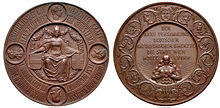Carl Radnitzky
Carl Radnitzky (born November 16, 1818 in Vienna ; † January 10, 1901 there ) was an Austrian die cutter and medalist . Signature: "C · R ·"; "C. Radnitzky ".
Life
Carl Radnitzky was the oldest of five children of the imperial court engraver and coin dealer Joseph Radnitzky (around 1793–1873) and Magdalena, née Grabo. His brother Joseph jun. (around 1820–1888) and his nephew Karl jun. (1855–1920) were later also imperial court engravers.
After attending the lower grades of the Schottengymnasium , Radnitzky attended the engraving academy of the Vienna Central Mint from 1836, where he learned the art of die cutting with Joseph Daniel Böhm . In 1837, Carl Radnitzky joined the main mint as an unpaid intern and was promoted to provisional engraving adjunct there in 1849. For his first major work, a Rubens Medal, he received the Reichel Prize of the Academy of Fine Arts in 1842, which enabled him to go on a study trip to Dresden , Leipzig and Berlin in 1843, accompanied by the opera singer Franz Hauser . The success in a competition of the Viennese coin engravers allowed him from 1847 on a further study trip at state expense, which took him to Germany , Belgium and France . After the outbreak of the February Revolution in 1848 , he returned to Vienna from Paris .
In 1850 Radnitzky was appointed to teach ornamental and figural modeling at the kk elementary modeling school of the academy. In 1853 he received the professorship for smaller sculpture, ornamentation and medal art and taught there, from 1872 as head of the special school for engraving and medal art until his retirement in 1881. His students included Joseph Edgar Böhm , Josef Tautenhayn , Anton Scharff , Friedrich Beer and Robert Weigl .
Radnitzky's work comprises several hundred commemorative coins and commemorative medals, including the medals for the unveiling of the monuments to Archduke Charles (1860) and Prince Eugen (1865), both on Heldenplatz , and the Schiller Memorial on Schillerplatz (1876). He created the Südbahn double thaler (1857), commemorative coins for the secular celebrations of Mozart (1856) and Beethoven (1870), and portrayed personalities such as Jenny Lind , the baron von Hammer-Purgstall , Friedrich Halm , Hermann Rollett , Franz Grillparzer and Franz Liszt . His larger works include a Beethoven bust for the Gesellschaft der Musikfreunde in Vienna and 15 medallions with portraits of artists for the 1st class box parapets of the Vienna State Opera .
In addition, Radnitzky, through the influence of his teacher JD Böhm, dealt with the art and cultural history of his Austrian homeland. He was a member of the Central Commission for Research and Conservation of Art Monuments and from 1868 to 1898 a member of the Board of Trustees of the kk Austrian Museum .
From Radnitzky's marriage to Maria Juliana (Julie) Mohr (1833–?), The daughter of a captain, came his son Ernst (1862–1939), later a lawyer and Secretary of the Treasury.
His grave is in the Grinzinger Friedhof , group 3, number 19 ( honorary grave of the city of Vienna since 1938).
literature
- Constantin von Wurzbach : Radnitzky, Karl . In: Biographisches Lexikon des Kaiserthums Oesterreich . 24th part. Imperial-Royal Court and State Printing House, Vienna 1872, p. 205 f. ( Digitized version ).
- Leonard Forrer: Radnitzky, Karl . In: Biographical Dictionary of Medallists . Volume 5, London 1912, pp. 11-16 ( digitized ).
- Fritz Dworschak: Carl Radnitzky (1818–1901) . In: Numismatic Journal 58 (1925), pp. 111-120.
- Bernhard Koch: Biographical contributions to the history of the Viennese coin die cutters and medalists . In: Numismatical Journal 82 (1967), pp. 53-85.
- Bernhard Koch: Radnitzky, Karl. In: Austrian Biographical Lexicon 1815–1950 (ÖBL). Volume 8, Verlag der Österreichischen Akademie der Wissenschaften, Vienna 1983, ISBN 3-7001-0187-2 , p. 380.
Individual evidence
- ↑ The date of birth follows Bernhard Koch; he was born at Fritz Dworschak's on November 17th.
- ↑ a b Stefan Krmnicek, Marius Gaidys: Taught images. Classical scholars on 19th century medals. Accompanying volume to the online exhibition in the Digital Coin Cabinet of the Institute for Classical Archeology at the University of Tübingen (= From Croesus to King Wilhelm. New Series, Volume 3). University Library Tübingen, Tübingen 2020, p. 38 f. ( online ).
- ↑ See Josef Beißer: Josef Radnitzky as a coin dealer . In: Communications of the Austrian Numismatic Society 13 (1963), issue 5, p. 38 f.
| personal data | |
|---|---|
| SURNAME | Radnitzky, Carl |
| ALTERNATIVE NAMES | Radnitzky, Karl |
| BRIEF DESCRIPTION | Austrian die cutter and medalist |
| DATE OF BIRTH | November 16, 1818 |
| PLACE OF BIRTH | Vienna |
| DATE OF DEATH | January 10, 1901 |
| Place of death | Vienna |


